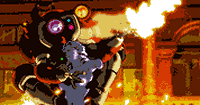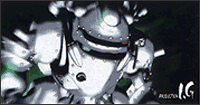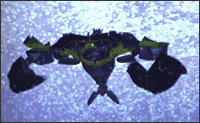
Anime Goes Digital (continued)
The Video Game Connection and the Next Generation
Of course, one of the most obvious uses for digitally assisted animation is
in the creation of video games. However, this doesn't mean that anime is
going to be overrun with VIRTUA FIGHTER-style
3D animation. Many studios have turned their eye towards
systems like Animo to create anime-quality 2D
cut scenes and openings for video games. Production I.G.,
for example, has used computer-assisted animation for
SAKURA TAISEN 2,
TALES OF DESTINY,
and of course, the
GHOST IN THE SHELL
PlayStation games. Many other game
companies and studios that work on games also use computer assisted animation.
Some have also begun turning their attention towards doing anime as well as
games.
 |
 

Production IG's GHOST IN THE SHELL and SAKURA TAISEN 2 video
games utilitized computer animation to achieve different effects. |
 GONZO is another studio that has been doing
digital animation for some time. They have worked on many game titles,
including the MACROSS:
DO YOU REMEMBER LOVE game and SILVER
STAR STORY. In these games, computer animation was
used to create some of the new anime footage for the game, and to enhance
certain other scenes. The difference in quality is noticeably higher. GONZO is another studio that has been doing
digital animation for some time. They have worked on many game titles,
including the MACROSS:
DO YOU REMEMBER LOVE game and SILVER
STAR STORY. In these games, computer animation was
used to create some of the new anime footage for the game, and to enhance
certain other scenes. The difference in quality is noticeably higher.
 |
 

AO NO ROKUGO used a lot of 3D animation in conjunction
with 2D animation. |
 However, GONZO is perhaps best known for their
current work on AO NO ROKUGO (BLUE SUBMARINE #6).
In the case of AO, GONZO undertook
the task of marrying both 3D and traditional
2D animation together. Past efforts at
this had been met with limited success, as seen by the early PANZER DRAGOON OVA.
However, the technology and
technique of the artists has come a long way in just a few years. And this
approach does not attempt to "disguise" the 3D aspect of
the animation, but rather to integrate it successfully into the medium. However, GONZO is perhaps best known for their
current work on AO NO ROKUGO (BLUE SUBMARINE #6).
In the case of AO, GONZO undertook
the task of marrying both 3D and traditional
2D animation together. Past efforts at
this had been met with limited success, as seen by the early PANZER DRAGOON OVA.
However, the technology and
technique of the artists has come a long way in just a few years. And this
approach does not attempt to "disguise" the 3D aspect of
the animation, but rather to integrate it successfully into the medium.
 |
 

Left: Digital Shipyard. The wireframe construction of
one of the ships in AO NO ROKUGO. Right: A finished version of the
ship placed in the scene. |
 In fact, mecha shows would seem to be ideally suited for computer-assisted
animation. Such thoughts are becoming common in the industry. Sunrise, for
example, has started to use computer effects for mecha. However, most
often, they are not using a 3D system, but are
instead using a 2D coloring
system to create special effects. Airbrushing, for example, can give a
more shiny, metallic edge to the robots and result in a more "real"
appearance. And of course, it's much easier and faster to do this on a
computer. Shows that have used these techniques include GUNDAM
W: ENDLESS WALTZ
and KING
OF BRAVES GAOGAIGAR. In fact, mecha shows would seem to be ideally suited for computer-assisted
animation. Such thoughts are becoming common in the industry. Sunrise, for
example, has started to use computer effects for mecha. However, most
often, they are not using a 3D system, but are
instead using a 2D coloring
system to create special effects. Airbrushing, for example, can give a
more shiny, metallic edge to the robots and result in a more "real"
appearance. And of course, it's much easier and faster to do this on a
computer. Shows that have used these techniques include GUNDAM
W: ENDLESS WALTZ
and KING
OF BRAVES GAOGAIGAR.
 |
 

This GUNDAM W image was computer-enhanced. GAOGAIGAR
also made use of computer-enhanced special effects, like this ripple. |
 Then again, it should come as no surprise to anime fans that Sunrise is
pursuing computer-assisted animation. After all, the versatility of the
medium was highlighted in its 1995 runaway hit series,
THE VISION OF ESCAFLOWNE.
And Sunrise Producer, Masami Masahiko, had also said that the
director of COWBOY BEBOP
wanted to use more computer animation in his show.
For example, in the space scenes, the planets are all done in 3D,
and computers handle some of the special effects as well. This represents a
growing trend in the industry. Then again, it should come as no surprise to anime fans that Sunrise is
pursuing computer-assisted animation. After all, the versatility of the
medium was highlighted in its 1995 runaway hit series,
THE VISION OF ESCAFLOWNE.
And Sunrise Producer, Masami Masahiko, had also said that the
director of COWBOY BEBOP
wanted to use more computer animation in his show.
For example, in the space scenes, the planets are all done in 3D,
and computers handle some of the special effects as well. This represents a
growing trend in the industry.
 |
 

Left: COWBOY BEBOP used digital animation for the planets and,
as shown here, during flight in hyperspace. Right: digital effects were used
for the pyrotechnics in this scene from ENDLESS WALTZ.
|
 Another area where computer animation is really starting to take hold is in
the opening and ending titles. Since the opening is intended to showcase
the best the show has to offer, animation companies often pull out all the
stops to deliver a high-quality, and often very stylized opening. The shows
that have used computer animation in some form or other in their openings
are becoming too numerous to mention, but include TAIHO SHICHAU
ZO!,
RUROUNI KENSHIN,
and more recently,
BUBBLEGUM CRISIS TOKYO 2040,
SILENT MÖBIUS,
NAZCA, and
STEAM DETECTIVES.
While not always subtle or carefully blended, the use of computer animation in
titles is on the rise. Another area where computer animation is really starting to take hold is in
the opening and ending titles. Since the opening is intended to showcase
the best the show has to offer, animation companies often pull out all the
stops to deliver a high-quality, and often very stylized opening. The shows
that have used computer animation in some form or other in their openings
are becoming too numerous to mention, but include TAIHO SHICHAU
ZO!,
RUROUNI KENSHIN,
and more recently,
BUBBLEGUM CRISIS TOKYO 2040,
SILENT MÖBIUS,
NAZCA, and
STEAM DETECTIVES.
While not always subtle or carefully blended, the use of computer animation in
titles is on the rise.
What They Do and Don't Do
Although computers are being used in animation more and more with each
passing year, many in the industry are still wary. Creators want to be
sure that they use the best tools available to achieve the desired results.
And while some, such as Sunrise and Production I.G. have
enthusiastically hoped on the computer-driven bandwagon, other companies have not.
 Most industry professionals agree that computer animation is good—in
limited amounts and for specific things. No one, for example, does their
drawing on the computer. Instead, the drawings are scanned into a computer
and then painted, rather than being drawn with a mouse on the computer
using an illustration program. Manga artists who use computers often only
use them for coloring and the addition of special effects, rather than
actually drawing their manga on a computer. Most industry professionals agree that computer animation is good—in
limited amounts and for specific things. No one, for example, does their
drawing on the computer. Instead, the drawings are scanned into a computer
and then painted, rather than being drawn with a mouse on the computer
using an illustration program. Manga artists who use computers often only
use them for coloring and the addition of special effects, rather than
actually drawing their manga on a computer.
 |
 

Despite the increasing use of computers in anime,
character art still tends to be drawn by hand before it is scanned
into the computer. |
 Another common use for computers is creation of backgrounds. Once a
very time-consuming task, computers allow background illustrators the freedom
to put in more details without adding additional work. Depending on the
production, the backgrounds can be simple 2D images that
would look the same had they been generated with traditional methods, or they
could be complex, detailed, backgrounds with 3D aspects,
like many of the backgrounds in AO NO ROKUGO. The ease
with which these backgrounds can be created allows for more detail without adding
time to the production schedule. Another common use for computers is creation of backgrounds. Once a
very time-consuming task, computers allow background illustrators the freedom
to put in more details without adding additional work. Depending on the
production, the backgrounds can be simple 2D images that
would look the same had they been generated with traditional methods, or they
could be complex, detailed, backgrounds with 3D aspects,
like many of the backgrounds in AO NO ROKUGO. The ease
with which these backgrounds can be created allows for more detail without adding
time to the production schedule.
 So computers ink and paint and assist in background creation, but they
don't draw. So computers ink and paint and assist in background creation, but they
don't draw.
 |
